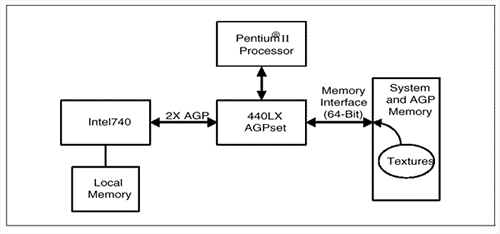2) Detailed Textures
On the first page of this article I discussed 3dfx's comments on the lack of support for textures larger than 256*256. One way around this is using detailed textures. It works like this: when you look at a wall from a distance you see your basic texture. When you are walking closer to it, you will see another texture mixed with your original texture. This second texture helps fill in the details on the wall. It works quite well and the results are amazing. The only drawback is that currently only the Unreal engine supports it. The only cards that run very well on the Unreal engine are 3dfx cards (cards that support Glide) and the upcoming Neon 250 which uses PowerSGL (Though the Direct3D performance is improving). I have seen Unreal running on the Neon 250 and it looks really nice, but who cares? Engines should not run on Glide or PowerSGL, they should use OpenGL or Direct3D! Whoops sorry, just some personal feelings..
3) AGP
AGP now makes it possible to use very large textures. Here possibly lies the explanation why 3dfx cards do not support large textures. The Voodoo 2&3 and Banshee do not support full AGP 2X/4X mode. Full AGP allows 3D cards to place and retrieve textures in the system memory (known as DME or Direct Memory Execution). This is something 3dfx based boards can't do. The image below displays how AGP works (from the i740 technical papers).

Not all cards that support full AGP 2X/4X mode are really good at doing this. When we look at second generation 3D accelerators, the only one that performed really well was the TNT. I hope that the new generation of 3D accelerators will change this for the better. With games that support larger textures, the use of AGP becomes important. Until now there were really no games the relied on AGP texturing (a few here and there), but that is changing. When AGP was introduced there were rumors that we did not need large amounts of ram on our video card. But the problem is that video ram is much faster as AGP. Now we are seeing cards on the market that have as much as 16 or 32MB of ram onboard. If this is needed, that remains to be seen. But a larger amount of ram onboard means that larger textures can be stored in the video ram and when that is full the card can switch to the system ram. When you look at some examples of texturing (the IHV demo of Q3A or the Unreal S3TC demos) you can find sizes as big as 2048*2048. These kind of textures takes up huge amounts of ram (12MB or more), so AGP will be very useful.
